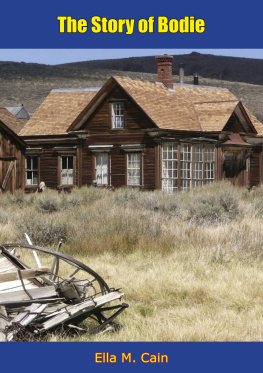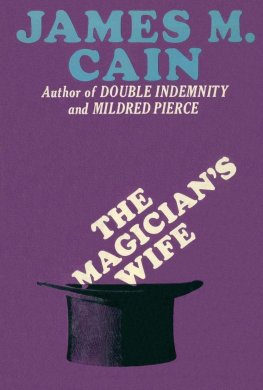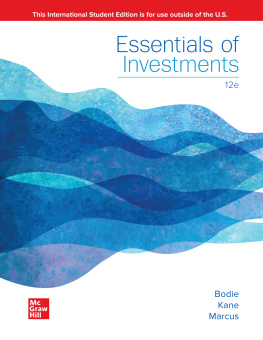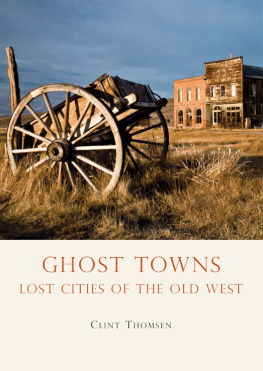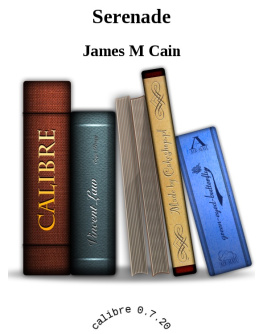

This edition is published by Papamoa Press www.pp-publishing.com
To join our mailing list for new titles or for issues with our books papamoapress@gmail.com
Or on Facebook
Text originally published in 1956 under the same title.
Papamoa Press 2017, all rights reserved. No part of this publication may be reproduced, stored in a retrieval system or transmitted by any means, electrical, mechanical or otherwise without the written permission of the copyright holder.
Publishers Note
Although in most cases we have retained the Authors original spelling and grammar to authentically reproduce the work of the Author and the original intent of such material, some additional notes and clarifications have been added for the modern readers benefit.
We have also made every effort to include all maps and illustrations of the original edition the limitations of formatting do not allow of including larger maps, we will upload as many of these maps as possible.
THE STORY OF BODIE
BY
ELLA M. CAIN
With an Introduction by
DONALD I. SEGERSTROM
TABLE OF CONTENTS
Contents
FOREWORD
During the Western expansion of these United States hardy and industrious Americans and Europeans were slowly developing the farming and timber lands on the outposts of civilization. It took the impetus of the discovery of gold in California and Nevada to cause a stampede westward such as the world has never known. Towns born of these discoveries sprang up over night, and, in a few months, housed a population of five, ten, and even fifteen thousand struggling humans.
Many of these towns are now deserted ghost towns and practically uninhabited, but they have left a heritage to these United States in a phase of American life that is well worth chronicling.
Such names as Hangtown, Marrietta, Calamity Jane, Julia Bulette and Jessie James are recognized by those who know the West, because much has been written about them, but Joseph DeRoche, Charlie Jardine, Pioche Kelly, and the rich lodes of Bodie, California, are practically unknown. Their stories have not been recorded in print, although the number of those who were shot, hanged, or run out of Bodie defy enumeration.
By 1869 the river of gold-seeking humanity had whirlpooled onto the eastern highlands of the Sierra Nevadas, into the Paiute country of Mono Basin, until the pinnacle was finally reached on the top of the world in Shooters Town.
The Bad Man from Bodie was a slogan that flashed around the United States in the early 70s, It originated from the fact that the vigilantes, who called themselves the Citizens Committee of 601, took the law into their hands to suppress and control the lawless element of the camp. Scores of bad characters were given 24 hours to leave townor else. Therefore, many an upright citizen, hailing from this distant camp, was embarrassed by the greeting Are you the bad man from Bodie?
As far back as I can remember I had a feeling that sometime I would write the story of Bodie, my birth-place, and my home town. This much I can tell you in truth: This history is authentic. These stories are true. These characters are real people, who made up the colorful background of this old camp. This history, these people, have been part of my life.
My father, M. J. Cody, came to Bodie in 1879, having, under President Cleveland, received an appointment as Land Office Receiver for this part of the West. In 1881 he married Catherine Shaughnessy of Virginia City, Nevada. I was born in Bodie in 1882. Several years later my father was elected Sheriff of Mono County, and the family moved to the County Seat in Bridgeport.
After my father had served two terms as Sheriff we moved back to Bodie. I graduated from the Grammar School there, and was sent away to complete my education.
In 19001 returned to Bodie to teach, as Intermediate Teacher in the Grammar School, which employed three teachers.
In 1904 I married David Victor Cain, whose family had been prominent residents of Bodie since 1879. To him I owe much of the history I have written, and without his collaboration and help I could not have gone on with this story.
There was never a gathering of old timers, never a fireside group, that stories of the lawless days of the old camp were not told. Always the thought came to me, Why should these tales die with the teller? As I heard them over and over again (and each old timer had his favorite stories), I began to take notes, Jot down funny incidents.
Later I began seriously to do some research work. I delved into the old files of the newspapers, the Coroners records, lodge records, the Miners Union books, and into the records in the county archives in Bridgeport.
In 1937 I had a severe and prolonged illness, from which I thought I might not recover. The unfinished story of Bodie was my greatest worry and concern. When I was able I wrote to George D. Lyman, who had been a classmate of mine in Nevada, and who had written that most successful and glamorous story, The Saga of the Comstock Lode. I offered him all my material, if he would accept it and write the story of Bodie. He answered thus:
San Francisco, Calif.
Sept. 10, 1937
Dear Ella:
Your generous offer just reached me. No doubt you will recover from the coronary thrombosis. That will take time and patience. The convalescent period will be a good time for you to complete your story of Bodie. My roots are in Virginia City, yours are in Bodie, and I know you will do justice to the story. Complete it.
I will be waiting with anticipation to read it when your book is published.
Most gratefully and sincerely yours,
George D. Lyman
So, at this late date, I have the material ready for the press.
I have tried to give you a true picture of the Bodie I knew. It is for you, who read this book, to judge whether or not Bodie deserved and sustained its reputation of being the most lawless, the wildest, and toughest mining camp the Far West has ever known.
ELLA M. CAIN
INTRODUCTION
This is the first book ever to be published about Bodie and its environs. It came to be printed and issued in a very interesting way.
In mid-Summer, 1953, Archie Stevenot of Sonora was in Mono County. He happened to call on Mrs. Ella Cain, as his sister had known her for years. Out of that conversation Archie learned that Mrs. Cain had recently completed a manuscript that was concerned with the history and life of the old ghost town of Bodie. Thus Mrs. Cain and her manuscript came to my attention.
During the Fall of 1953 I talked with Mrs. Cain several times and induced her to allow me to make the effort to see that her manuscript, and a portion of her fine collection of photographs, were put into print. I felt that her background as a lifelong resident of Bodie, and her years of school teaching, well qualified her to tell the story of one of the most fabulous mining camps that ever existed in the Old West.
Now, as Mrs. Cains book comes from the press, it is more than coincidental that the California State Legislature has passed a bill, signed into law by Governor Goodwin J. Knight. It allows for funds to establish the ghost town of Bodie as an Historical Park unit of the California State Park System.
I am very pleased to have had a hand in the book and the effort put forth to establish Bodie State Park. Both of them will preserve history firsthand for generations to come.
It shall forever be to Mrs. Cains glory that she struggled against almost impossible odds to save these valuable links with the colorful past of Mono County.
Next page
